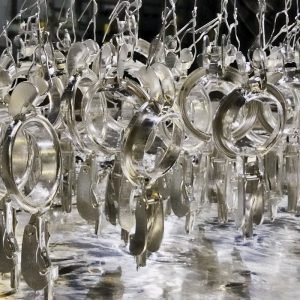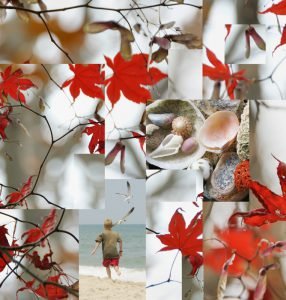+ By Julia Gibb
Long before ever capturing an image with a camera, Celia Pearson experienced a visual awakening during a childhood immersed in environmental beauty. Growing up on a farm outside of Washington, DC, she was free to roam the countryside, riding her pony through what seemed to be endless acres of farmland, traveling lanes and fields that took her from one farm to the next. In the summer, she stayed with her paternal grandparents in their home on a small island off of Kittery Point, Maine. There, along the shore with her family, Pearson says, “We collected things, always. That place where the land meets the sea is a very special place to me.” It’s a perfect metaphor for the liminal space Pearson explores through her creative process. Through this lens, finely attuned to beauty, Pearson finds compositions, shapes, and patterns, filling her work with the energy of the unseen.
Local photographer the late Dick Bond was Pearson’s first and only teacher—and the reason she became a photographer. “He was a scientist in a state of wonder,” she says. Bond taught photography at the tiny Stratus Gallery on State Circle, where Pearson took her first class in 1972. When Pearson told him, “I want to photograph what you can’t see,” he responded, “You can’t photograph what you can’t see!” But Pearson strives to go into, beyond, and beneath the outer appearance of her subjects. “I’m not only seeing the surface beauty, I’m experiencing something else. And that is what drives my work the most.”
In the late 1970s, Pearson created and exhibited fine art photography around Annapolis. In 1979, she started a business as an assignment photographer. After 20 successful years, during which she developed a national reputation for her work photographing interior spaces, gardens, and architecture, she yearned to follow her muse while continuing on her professional path. Her vision and creativity compelled her to return gradually to fine art photography, her true love.
Pearson’s process is visceral and intuitive. “Making art slows me down and hushes my busy mind,” she says, “I find more breathing room.” Within that quietude resides a transformative experience that simultaneously transports her deeper within and outside of herself. While creating and observing, she waits to feel the shift in mind and body for that moment when gut instinct compels her to press the shutter button.
The composition of Pearson’s works reflects the relationship that develops between artist and subject. Luminous pieces of sea glass are placed deliberately, creating a meditation of form, color, and light. Sometimes compositions wait patiently for discovery inside a seashell or in the rhythmic growth habit of a plant. Zooming in on these lyrical moments creates a sense of intimacy. Using a shallow depth of focus enhances the works’ abstract quality, bringing only small portions of the subject into focus while letting the rest remain dreamily soft and painterly. The transition from out of focus to sharp creates a dynamic juxtaposition of movement and rest in these still lifes.
Travels in Southeast Asia in 2008 and 2009 exposed Pearson to a deluge of visual, aural, and olfactory stimuli, pushing her beyond traditional ways of composing and presenting her work. Exploring Cambodia, Thailand, and Vietnam with only a professional-grade point-and-shoot, a panoramic camera, and an old 35-millimeter camera, she documented landscapes, cityscapes, architecture, art, and street life. The resulting imagery demanded a different process of creating and displaying the body of work that would become her exhibit titled Layerings: A Glimpse of Southeast Asia. Pearson created photomontages, combining multiple images with diverse but sympathetic colors and textures, allowing the images at times to show the seams where they abut other images. Her montages encapsulate the bombardment of stimuli while finding common threads of color and texture running through the images.
Inspired by the textiles and rice paper seen in her travels, she printed works on silk, some displayed on their own, hanging unframed and unfettered at their bottom edge, free to shift with currents of air. Other prints on the diaphanous fabric hung sometimes in front of another static image printed on paper, combining the two in an ever-shifting, ethereal landscape.
In a body of work called A Door Opens, Pearson revisits some of her previous subjects—sea glass, shells, and plants, along with hints of architecture. Some of these works are photomontages, bringing disparate yet harmonious subjects together. Others feature images of actual doors. But the feeling here is that in the artist’s soul a new door has opened, and she has eagerly walked through it, lured in by the exploration of yet another facet of her art.
While Pearson chose the subject matter for bodies of work, such as What We Collect, and Things That Grow, sometimes, she says, the subjects choose her. This was the case with her series called Glass Transformed, which began when author and sea glass researcher Richard Lamotte asked her to create the photographs to illustrate his first book, Pure Sea Glass: Discovering Nature’s Vanishing Gems. The experience led to many more months in her studio, photographing a now-beloved subject, always only with available light, as is her way with all of her art.
Another of Pearson’s exhibits, Molten Beauty: The Soul of an American Galvanizing Plant, evolved in similar fashion. The recipient of one of Pearson’s yearly photography calendars, Kathleen Ortel, sought her out to photograph a century-old industrial workplace in Johnstown, Pennsylvania, for a customized calendar. The company, Korns Galvanizing, does the more intricate galvanizing jobs that larger, automated plants can’t handle. Pearson was immediately excited by the heat, sound, and energy of the place, along with the obvious pride employees took in their work. “It was such an honest, raw, gritty place, “ she says. “[You could] feel the heartbeat of the universe in it.” She envisioned an exhibit, and Ortel forged a collaboration between artist and company to bring it to fruition. Pearson printed large-scale works on silk and on uncoated, fine-woven canvas, and loves the effect, saying, “You can’t tell it’s canvas. It doesn’t reflect light, [there’s] a richness that’s remarkable.”
Pearson believes that we are all artists. The rapid advance of technology, which allows nearly everyone to have some sort of camera on hand at almost every moment, has inspired an explosion of creativity. This presents both a boon and a challenge to photographers who have spent decades accumulating knowledge and working. Pearson strives to make her work accessible at a variety of price points, offering posters, notecards, and the yearly calendar, in addition to her limited edition prints. A book of her works from Molten Beauty, along with some writings, is in progress.
Nicole Wolf, Pearson’s 91-year-old mother, also lives in Eastport, and Pearson and her two sisters help care for her. A retired professional modern dancer, Wolf empathizes with her daughter’s artistic spirit and is one of her most trusted advisors. She often traveled with Pearson and accompanied her on her first trip to Southeast Asia. She contributed the title Layerings to the resulting body of work. Wolf had endless patience when her daughter would stop and make photographs. “She would just sit and wait . . . She has always been an observer—she was content, occupied.” Pearson’s voice fills with emotion as she reads aloud from her book-in-progress, Molten Beauty: “This book is dedicated to Nicole Rose-marie Wolf, my mother and lifelong muse. We are fellow travelers, kindred spirits. I am deeply grateful for her presence.” █
See Celia Pearson’s work at
www.celiapearson.com.



























